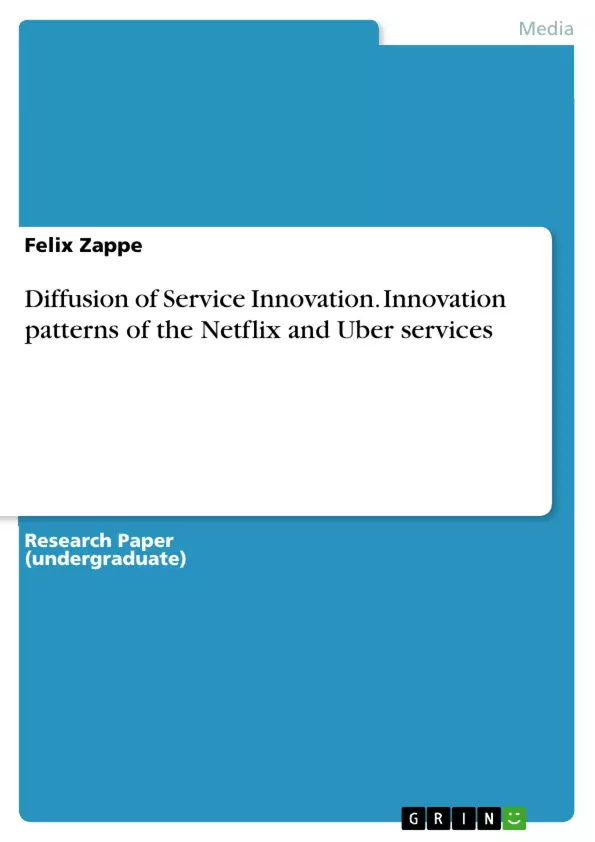Describing innovation in terms of the adoption of new technologies does not appear to best capture innovation in services. How are services innovative in different ways? This work discusses this question with reference to two specific examples of services, i.e. Uber and Netflix, with regard to their company history. For that purpose it describes conservative innovation diffusion patterns and describes the service innovation capability approach.
Inhaltsverzeichnis (Table of Contents)
- SERVICES - THEORETICAL BACKGROUND
- SERVICES - CHARACTERISTICS AND DEFINITION
- THE SERVICE-DOMINANT LOGIC
- INNOVATION - THEORETICAL BACKGROUND
- INNOVATION TERM AND THE TRADITIONAL INNOVATION PROCESS
- APPROACHES TO INNOVATION DIFFUSION
- SERVICE INNOVATION APPROACH TO INNOVATION DIFFUSION
- EXAMPLES: THE INNOVATIONS AND DIFFUSIONS OF NETFLIX AND UBER
- CONCLUSION
Zielsetzung und Themenschwerpunkte (Objectives and Key Themes)
This essay explores the concept of service innovation, arguing that the traditional view of innovation focused on technology adoption does not adequately capture the unique aspects of service innovation. The paper aims to understand how services innovate differently and to analyze the diffusion of these innovations in the market.
- Characteristics and definitions of services
- The service-dominant logic (S-D logic) and its implications for innovation
- Approaches to innovation diffusion, including service innovation approaches
- Case studies of Netflix and Uber as examples of service innovation and diffusion
Zusammenfassung der Kapitel (Chapter Summaries)
- SERVICES - THEORETICAL BACKGROUND: This chapter discusses the theoretical foundation of services, including their characteristics and definition. It emphasizes the importance of the service-dominant logic, which views services as more prevalent than goods and goods as merely means of delivering services.
- INNOVATION - THEORETICAL BACKGROUND: This chapter examines the concept of innovation and its diffusion. It explores traditional approaches to innovation diffusion, emphasizing the significance of technology adoption. This chapter also introduces the service innovation approach, which focuses on the unique aspects of innovation in services.
- EXAMPLES: THE INNOVATIONS AND DIFFUSIONS OF NETFLIX AND UBER: This chapter delves into the specific cases of Netflix and Uber, analyzing their innovations and diffusion processes. It utilizes theoretical frameworks to illustrate how these services have disrupted traditional business models and achieved widespread adoption.
Schlüsselwörter (Keywords)
The essay focuses on key concepts such as service innovation, service-dominant logic, innovation diffusion, technology adoption, and the role of customer co-production. It also analyzes specific examples of service innovations, such as Netflix and Uber, and explores the underlying factors driving their success and widespread adoption in the market.
- Quote paper
- Felix Zappe (Author), 2017, Diffusion of Service Innovation. Innovation patterns of the Netflix and Uber services, Munich, GRIN Verlag, https://www.grin.com/document/358172



